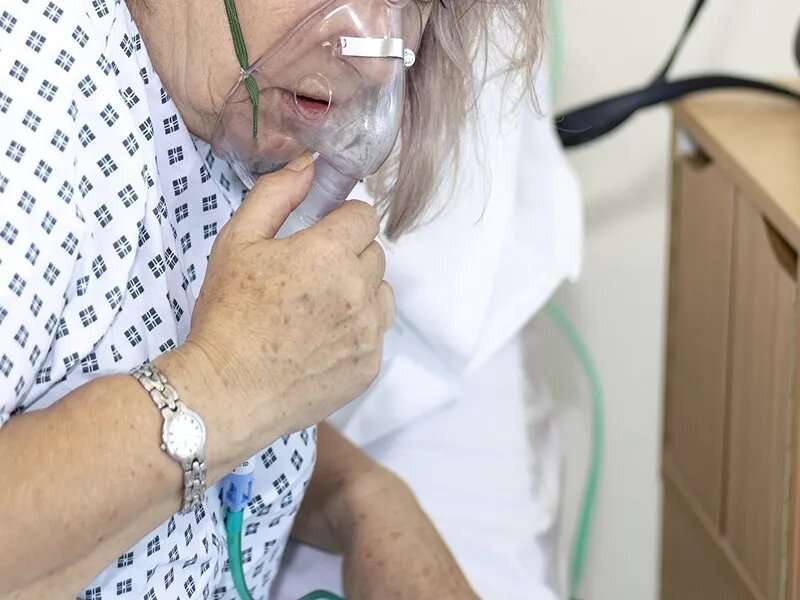Putting hospitalized COVID patients on their bellies may not be a good idea after all

Placing hospitalized COVID-19 patients on their stomach is helpful if they're on a mechanical ventilator, but a new study suggests it's not a good idea for patients who are not intubated.
"Awake" COVID patients—as opposed to ventilated patients who are kept sedated—did not benefit from lying on their stomach while struggling for breath, according to clinical trial results published online April 18 in JAMA Internal Medicine.
In fact, awake COVID-19 patients asked to prone did somewhat worse short-term than those left on their backs, said lead researcher Dr. Todd Rice, an associate professor of allergy, pulmonology and critical care medicine at Vanderbilt University in Nashville, Tenn.
Their blood oxygen levels were lower, and they tended to remain sicker, Rice said.
After five days of proning, "fewer of them were discharged to home and more of them were on mechanical ventilators than the group that didn't prone," he said.
Proning is a strategy for improving oxygen levels in ventilated patients that's been practiced for decades in the United States, and previous clinical trial results have supported its use, said Dr. Peter Sottile, an assistant professor of pulmonology and critical care medicine at the University of Colorado, in Aurora.
In the early days of the pandemic, desperate doctors started to ask awake COVID-19 patients to prone as well, Sottile said. The hope was that proning would keep patients' oxygen levels high enough that they wouldn't need to go on a ventilator—devices that were in desperately short supply.
"In March of 2020, when Italy and New York were being overrun and there were significant concerns about whether we're going to have enough ventilators for all these patients, and what can we do to try to keep people off the ventilator—that's when prone positioning of awake patients really came back as something to consider and see if it works," said Sottile, who wrote an editorial published April 18 with the new study.
Doctors could point to one COVID patient or another and say that proning had helped keep them off the ventilator, but such anecdotal evidence doesn't prove it's an effective strategy, Sottile said.
Further, some observational studies had shown that asking awake patients to prone could improve their oxygen levels, but those studies didn't show whether it kept their COVID from progressing, Rice said.
So Rice and his colleagues recruited about 500 hospitalized COVID-19 patients to test whether proning actually would help them. Roughly half chosen at random were asked to lie on their stomachs for as long as they could every day.
By day five, the proning patients were more likely to be worse off than patients left on their backs, the study results showed.
"Patients over those first five days steadily got worse in the proning group," Rice said. "They looked slightly worse each day than the supine group, suggesting that it's a slowly progressive worsening and not an acute process where somebody turned over and suddenly they got sick."
After 28 days, the two groups had no differences in terms of death, their progression to mechanical ventilation, or length of their hospital stay.
There are a couple of possible explanations for why awake patients might not respond well to proning, Rice and Sottile said.
First off, awake people can't comfortably lie on their stomachs for as long as unconscious ventilated patients, so they might not be able to stay prone long enough to benefit from the position.
"It's not that comfortable for awake people to lay on their stomach for long periods of time, so we encourage them to prone for as long as they can possibly tolerate it," Rice said. "And that turned out to be on average about between four and five hours a day."
That's far less time in the prone position than has been required in ventilated patients to be effective, Sottile said.
"Past studies have shown that we need 16 hours or more a day in the prone position to receive benefit," he said. "Asking an awake patient to lay on their belly for 16 hours a day is really probably not feasible. It's a hard thing to ask someone to do day in and day out."
It's also possible that proning might actually help spread the virus or inflammation to still-healthy parts of the lung, Rice said, "as opposed to when you're on the ventilator and all of your lung is already involved."
He said doctors who treat COVID-19 patients might want to rethink asking them to prone while they're still well enough to be off a ventilator.
"There are a lot of guidelines that suggest doing this in patients who aren't yet mechanically ventilated," Rice said. "I think our study throws a little caution" regarding those guidelines.
More information: Penn Medicine has more on proning COVID patients.
Edward Tang Qian et al, Assessment of Awake Prone Positioning in Hospitalized Adults With COVID-19, JAMA Internal Medicine (2022). DOI: 10.1001/jamainternmed.2022.1070
Peter D. Sottile et al, Prone Positioning for Nonintubated Patients With COVID-19—Potential Dangers of Extrapolation and Intermediate Outcome Variables, JAMA Internal Medicine (2022). DOI: 10.1001/jamainternmed.2022.1086
2022 HealthDay. All rights reserved.





















